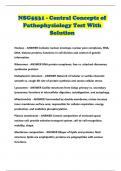Karyolysis - Study guides, Class notes & Summaries
Looking for the best study guides, study notes and summaries about Karyolysis? On this page you'll find 90 study documents about Karyolysis.
Page 3 out of 90 results
Sort by
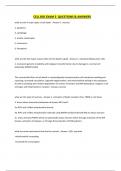
-
CELL BIO EXAM 3 QUESTIONS & ANSWERS
- Exam (elaborations) • 34 pages • 2024
-
- $16.49
- + learn more
CELL BIO EXAM 3 QUESTIONS & ANSWERS what are the 6 major types of cell death - Answer-1. necrosis 2. apoptosis 3. autophagy 4. mitotic catastrophe 5. senescence 6. ferroptosis what are the two major reasons that cell-cell death is good - Answer-1. maximize killing cancer cells 2. to prevent genomic instability and malignant transformation due to damage in a normal cell (especially dsDNA breaks) This uncontrolled form of cell death is morphologically characterized by cell membrane swel...
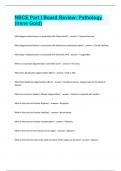
-
NBCE Part I Board Review- Pathology (Irene Gold)| latest update
- Exam (elaborations) • 12 pages • 2024
-
- $14.99
- + learn more
What degenerative feature is associated with Tuberculosis? - answer:> Caseous Necrosis What degenerative feature is associated with albuminous membrane injury? - answer:> Cloudy Swelling What type of degeneration is associated with Infarction (MI) - answer:> Coagulation Where is enzymatic degeneration most often seen? - answer:> Pancreas What does liquefaction degeneration effect? - answer:> CNS or Skin What does Wallerian degeneration effect? - answer:> Peripher...
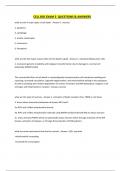
-
CELL BIO EXAM 3 QUESTIONS & ANSWERS
- Exam (elaborations) • 34 pages • 2024
-
- $16.49
- + learn more
CELL BIO EXAM 3 QUESTIONS & ANSWERS what are the 6 major types of cell death - Answer-1. necrosis 2. apoptosis 3. autophagy 4. mitotic catastrophe 5. senescence 6. ferroptosis what are the two major reasons that cell-cell death is good - Answer-1. maximize killing cancer cells 2. to prevent genomic instability and malignant transformation due to damage in a normal cell (especially dsDNA breaks) This uncontrolled form of cell death is morphologically characterized by cell membrane swel...
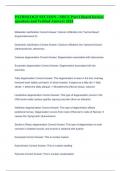
-
PATHOLOGY SECTION - NBCE Part I Board Review questions and Verified Answers 2024
- Exam (elaborations) • 32 pages • 2024
-
Available in package deal
-
- $10.39
- + learn more
PATHOLOGY SECTION - NBCE Part I Board Review questions and Verified Answers 2024 Metastatic calcification Correct Answer: Calcium infiltration into *normal tissue* (Hypervitaminosis D) Dystrophic calcification Correct Answer: Calcium infiltration into *abnormal tissue* (atherosclerosis, atheroma) Caseous degeneration Correct Answer: Degeneration associated with tuberculosis Enzymatic degeneration Correct Answer: Degeneration associated with the pancreas Fatty degeneration Correc...
NSG5531 - Central Concepts of Pathophysiology Test With Solution...
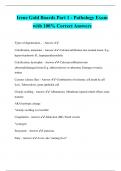
-
Irene Gold Boards Part 1 - Pathology Exam with 100% Correct Answers
- Exam (elaborations) • 41 pages • 2024
- Available in package deal
-
- $13.49
- + learn more
Irene Gold Boards Part 1 - Pathology Exam with 100% Correct Answers Types of degeneration... - Answer ️️ - Calcification, metastatic - Answer ️️ -Calcium infiltration into normal tissue. E.g. hypervitaminosis D., hyperparathyroidism Calcification, dystrophic - Answer ️️ -Calcium infiltration into abnormal/damaged tissue E.g. atherosclerosis or atheroma. Damage to tunica intima Caseous (cheese like) - Answer ️️ -Combination of ischemic cell death & cell lysis. Tuberculosi...
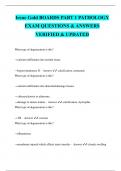
-
Irene Gold BOARDS PART 1 PATHOLOGY EXAM QUESTIONS & ANSWERS VERIFIED & UPDATED
- Exam (elaborations) • 65 pages • 2024
- Available in package deal
-
- $13.49
- + learn more
Irene Gold BOARDS PART 1 PATHOLOGY EXAM QUESTIONS & ANSWERS VERIFIED & UPDATED What type of degeneration is this? →calcium infiltration into normal tissue →hypervitaminosis D - Answer ️️ -calcification, metastatic What type of degeneration is this? →calcium infiltration into abnormal/damage tissues → atherosclerosis or atheroma →damage to tunica intima - Answer ️️ -calcification, dystrophic What type of degeneration is this? →TB - Answer ️️ -caseous What type ...
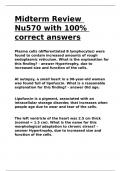
-
Midterm Review Nu570 with 100% corerect answers
- Exam (elaborations) • 19 pages • 2024
-
- $14.49
- + learn more
Plasma cells (differentiated B lymphocytes) were found to contain increased amounts of rough endoplasmic reticulum. What is the explanation for this finding? Hypertrophy, due to increased size and function of the cells. At autopsy, a small heart in a 90-year-old woman was found full of lipofuscin. What is a reasonable explanation for this finding? Old age. Lipofuscin is a pigment, associated with an intracellular storage disorder, that increases when people age due to wear and tear o...
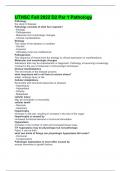
-
UTHSC Fall 2022 D2 Par 1 Pathology
- Exam (elaborations) • 21 pages • 2024
-
- $10.49
- + learn more
UTHSC Fall 2022 D2 Par 1 Pathology Pathology the study of disease Pathology consists of what four aspects? - Etiology - Pathogenesis - Molecular and morphologic changes - Clinical manifestations Etiology The cause of the disease or condition - Genetic - Acquired - Ultimately most are multifactorial Pathogenesis The sequence of events from the etiology to clinical expression or manifestations Molecular and morphologic changes Alterations that may be characteristic or diagnostic. P...

-
HESI (PATHO BOOK) Exam Fall 2022. Complete Solution With Rationale 100%
- Exam (elaborations) • 63 pages • 2024
-
- $18.99
- + learn more
HESI (PATHO BOOK) Exam Fall 2022. Complete Solution With Rationale 100% A decrease in workload, use, pressure, or blood supply appropriately describes: A. physiologic atrophy. B. pathologic atrophy. C. hypertrophy. D. hyperplasia. B. pathologic atrophy. Pathologic atrophy is a decrease in cell size due to decreased use. Physiologic atrophy usually occurs early in development; for example, the thymus gland atrophies during childhood. Hypertrophy is an increase in cell size. Hyperplasia...

Study stress? For sellers on Stuvia, these are actually golden times. KA-CHING! Earn from your study resources too and start uploading now. Discover all about earning on Stuvia

